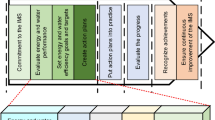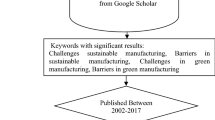Abstract
Resource efficiency is a crucial factor for the competitiveness of the manufacturing industry in Germany. It provides a significant potential for cost reduction and helps companies to become more independent from the supply and cost risks related to the international raw material markets. Resource efficient manufacturing is also a key element for achieving the international and national goal for climate protection. The Federal German Climate Protection Plan demands an industrial CO2 reduction of 50% by 2030 (see German Ministry for the Environment, Nature Conservation, Building and Nuclear Safety BMUB. Klimaschutzplan 2050. http://www.bmub.bund.de/fileadmin/Daten_BMU/Download_PDF/Klimaschutz/klimaschutzplan_2050_bf.pdf. Accessed 3 Jan 2017, 2016a). This can only be achieved by the continuous implementation of more resource efficient technologies and processes. To this end, national and international norms and standards can contribute significantly to the dissemination of best available technologies.
To our knowledge, the new VDI Standard 4800, published in 2016, is the first technical standard for defining, evaluating and calculating resource efficiency (see VDI 4800 Part 1, Ressourceneffizienz – Methodische Grundlagen, Prinzipien und Strategien. Beuth Verlag GmbH, Berlin, 2016). The standard contains 37 strategies and measures to increase resource efficiency in companies. They address the improvement of in-house company procedures, adapting or changing technologies in the production processes or new approaches in the product development process.
The sector and technology-specific services offered by the VDI Centre for Resource Efficiency (VDI ZRE) address this complexity in all its aspects. In addition to supplying extensive information and examples, companies are offered cross-regional informative events and qualification courses for successful material and energy efficiency strategies. VDI ZRE furthermore cooperates closely with German state and regional agencies and authorities, Chambers of Commerce, Chambers of Trade and many related associations.
Access this chapter
Tax calculation will be finalised at checkout
Purchases are for personal use only
Similar content being viewed by others
Notes
- 1.
Own illustration on the basis of the Statistical Yearbooks of the Federal Sta-tistical Office of Germany (values for 1993–2009) and the yearly Cost Structure Statistic Publications (values for 2010–2014) (see Statistisches Bundesamt 2016).
- 2.
Note: the authors apply the term differential costs, as the complexity of material-related cost reduction prohibits calculating all parameters for their analysis. A common procedure, differential cost analyses are applied to economic analyses to cope with complex parameters.
- 3.
Today, approximately 200 Standards based on the latest technical develop-ments are produced by the VDI’s technical divisions per year. That way the VDI has systematically built up a set of technical regulations, which today contains more than 2000 valid VDI Standards extensively covering the broad field of technology. Today’s topics range from securing loads on road vehicles to testing of optical fibres up to biomimetics and monitoring the consequences of genetically modified organisms.
- 4.
- 5.
See www.ressource-deutschland.de, some tools are also available in English at www.resource-germany.com
- 6.
- 7.
YouTube channel: “Ressource Deutschland”.
- 8.
www.netzwerk-ressourceneffizienz.de (Only available in German).
- 9.
www.industrieclub-ressourceneffizienz.de (Only available in German).
References
German Ministry for the Environment, Nature Conservation, Building and Nuclear Safety BMUB (2012) Deutsches Ressourceneffizienzprogramm (ProgRess) - Programm zur nachhaltigen Nutzung und zum Schutz der natürlichen Ressourcen http://www.bmub.bund.de/themen/wirtschaft-produkte-ressourcen-tourismus/ressourceneffizienz/deutsches-ressourceneffizienzprogramm/progress/. Accessed 27 Jan 2017
German Ministry for the Environment, Nature Conservation, Building and Nuclear Safety BMUB (2016a) Klimaschutzplan 2050. http://www.bmub.bund.de/fileadmin/Daten_BMU/Download_PDF/Klimaschutz/klimaschutzplan_2050_bf.pdf. Accessed 3 Jan 2017
German Ministry for the Environment, Nature Conservation, Building and Nuclear Safety BMUB (2016b) Deutsches Ressourceneffizienzprogramm II. Programm zur nachhaltigen Nutzung und zum Schutz der natürlichen Ressourcen. http://www.bmub.bund.de/fileadmin/Daten_BMU/Pools/Broschueren/progress_ii_broschuere_bf.pdf. Accessed 3 Jan 2017
Statistisches Bundesamt (2015) Industrial sector in Germany remains stronger than in many other EU Member States https://www.destatis.de/Europa/EN/Topic/IndustryTradeServices/IndustryTradeServices.html. Accessed 3 Jan 2017
Statistisches Bundesamt (2016) Kostenstruktur der Unternehmen des Verarbeitenden Gewerbes - Ältere Ausgaben https://www.destatis.de/DE/Publikationen/Thematisch/IndustrieVerarbeitendesGewerbe/AlteAusgaben/KostenstrukturAlt.html. Accessed 3 Jan 2017
VDI 4800 Part 1 (2016) Ressourceneffizienz – Methodische Grundlagen, Prinzipien und Strategien. Beuth Verlag GmbH, Berlin
VDI 4800 Part 2 [draft] (2016) Ressourceneffizienz – Bewertung des Rohstoffaufwands. Beuth Verlag GmbH, Berlin
VDI 4801 [draft] (2016) Ressourceneffizienz in kleinen und mittleren Unternehmen (KMU) – Strategien und Vorgehensweisen zum effizienten Einsatz natürlicher Ressourcen. Beuth Verlag GmbH, Berlin
VDI ZRE (2013) Analyse von Potenzialen der Material- und Energieeffizienz in ausgewählten Branchen der Metall verarbeitenden Industrie http://www.ressource-deutschland.de/fileadmin/user_upload/downloads/studien/Studie_ee_web.pdf. Accessed 3 Jan 2017
VDI ZRE (2016) Ressourceneffizienz im Leichtbau http://www.ressource-deutschland.de/fileadmin/user_upload/downloads/kurzanalysen/Kurzanalyse_17_Ressourceneffizienz_im_Leichtbau.pdf. Accessed 3 Jan 2017
VDI ZRE (a) Injection moulding. http://www.resource-germany.com/instruments/resource-checks/for-companies/injection-moulding/questionaire. Accessed 03 Jan 2017a
VDI ZRE (b) Produktionsinfrastrukur. http://www.ressource-deutschland.de/instrumente/prozessketten/produktionsinfrastruktur. Accessed 3 Jan 2017b
Woidasky J, Ostertag K, Stier C (2013) Innovative Technologien für Ressourceneffizienz in rohstoffintensiven Produktionsprozessen. Ergebnisse der Fördermaßnahme r2. Fraunhofer Verlag, Stuttgart
Disclaimer
This paper does not necessarily reflect the opinion or the policies of the German Federal Environment Agency.
Author information
Authors and Affiliations
Corresponding author
Editor information
Editors and Affiliations
Rights and permissions
Copyright information
© 2018 Springer International Publishing AG
About this chapter
Cite this chapter
Maass, W., Oberender, C., Vogt, M. (2018). Resource Efficiency for the Manufacturing Industries – A Holistic Approach. In: Lehmann, H. (eds) Factor X. Eco-Efficiency in Industry and Science, vol 32. Springer, Cham. https://doi.org/10.1007/978-3-319-50079-9_29
Download citation
DOI: https://doi.org/10.1007/978-3-319-50079-9_29
Published:
Publisher Name: Springer, Cham
Print ISBN: 978-3-319-50078-2
Online ISBN: 978-3-319-50079-9
eBook Packages: Earth and Environmental ScienceEarth and Environmental Science (R0)




